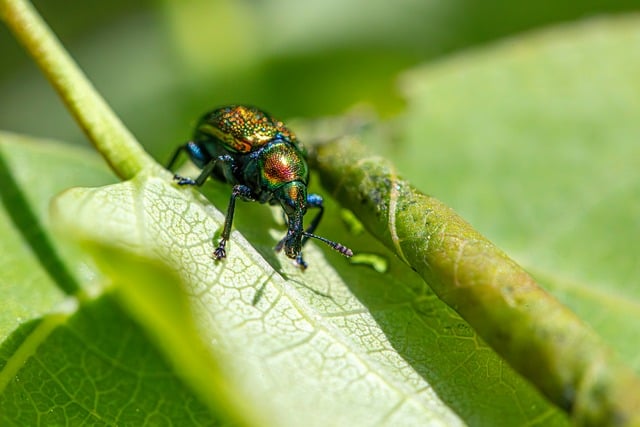Grain weevil infestations caused by Rhyzopertha dominica pose significant agricultural challenges, impacting wheat, corn, and rice. These pests enter through contaminated grains or infested storage facilities, leading to direct crop loss, reduced market value, and costly treatments. Effective long-term prevention requires a multifaceted approach: sanitation protocols, regular cleaning, proper ventilation, integrated pest management (IPM), physical barriers, biological control methods, targeted chemical treatments, and regular monitoring by trained personnel. By implementing these strategies, customized for unique storage environments, farmers can minimize grain weevil infestations, ensure product safety, and maintain high-quality stored grains.
Grain weevils can cause significant damage to stored crops, posing a major challenge for farmers. This article offers a comprehensive guide to long-term prevention strategies for grain weevil infestation treatment. We explore the causes and impact of these pests, providing insights into effective control methods. A step-by-step approach to creating customized plans is detailed, emphasizing the importance of a holistic strategy. By implementing these measures, farmers can safeguard their crops, ensuring sustainability and minimizing economic losses associated with grain weevil infestations.
Understanding Grain Weevil Infestations: Causes and Impact
Grain weevil infestations are a common pest issue, particularly in agricultural settings, and understanding their causes and impacts is crucial for effective prevention. These pests, often referred to as Rhyzopertha dominica, are capable of causing significant damage to stored grains such as wheat, corn, and rice. The primary entry points for weevils are usually through contaminated grains or infested storage facilities. Once inside, they feed on the kernels, laying eggs, and continuing their lifecycle, leading to a rapid population increase.
The impact of grain weevil infestations is far-reaching. Apart from the direct loss of crops due to damage, contaminated grains can also lead to reduced quality and value in the market. Additionally, treating infestations requires specialized grain weevil infestation treatment methods, including pest control applications and storage facility modifications, which can be costly and time-consuming. Therefore, implementing customized prevention plans is essential to mitigate these issues and ensure long-term protection for stored grains.
Long-Term Prevention Strategies: A Comprehensive Approach
Long-term prevention of grain weevil infestations requires a comprehensive, multi-faceted approach that goes beyond immediate treatment. It’s about creating an environment that discourages these pests from ever taking hold. This involves a combination of strategies focusing on sanitation, storage practices, and environmental management.
By implementing strict sanitation protocols, regularly cleaning and disinfecting storage areas, and maintaining proper ventilation, you significantly reduce the risk of grain weevil infestation treatment needs. Additionally, adopting integrated pest management (IPM) techniques allows for the use of biological control agents and targeted chemical treatments only when necessary, minimizing exposure to pests while also preserving the ecological balance within your storage facilities.
Creating a Customized Plan for Effective Grain Weevil Control
Creating a customized plan for effective grain weevil control involves understanding the unique dynamics of your storage environment and target species. Unlike one-size-fits-all solutions, tailored strategies consider factors like the type of grains stored, storage facility design, climate, and local pest population. A comprehensive approach might include implementing physical barriers such as airtight containers and pest-proof flooring to prevent initial infestations.
Additionally, integrating biological control methods, like introducing natural predators or using pheromone traps, can disrupt grain weevil reproduction cycles. Chemical treatments should be reserved for targeted applications, utilizing insect growth regulators or specific insecticides effective against weevils while minimizing environmental impact. Regular monitoring and maintenance, coupled with these diverse tactics, form the backbone of a robust, long-term grain weevil infestation treatment strategy.
Implementation and Monitoring: Ensuring Success Over Time
Implementing a customized plan for long-term prevention of grain weevils requires a dedicated and systematic approach. Once strategies such as proper storage, sanitation, and physical barriers are put in place, regular monitoring becomes paramount to ensure success over time. This involves routine inspections to identify any signs of infestation at an early stage, enabling swift action. By maintaining detailed records of these checks and treating potential issues promptly, the risk of grain weevil infestation treatment can be significantly minimized.
Monitoring should include checking stored grains for any signs of damage or unusual activity. Trained personnel can detect subtle changes that might indicate a reinfestation attempt. This proactive measure, coupled with ongoing adherence to storage best practices, creates an environment hostile to grain weevils, ensuring the long-term safety and quality of the stored product.
Grain weevil infestations can be effectively managed through customized, long-term prevention plans. By understanding the causes and impact of these infestations, farmers and agricultural professionals can implement comprehensive strategies that address the issue at its root. A tailored approach, combining improved storage practices, biological controls, and regular monitoring, offers sustainable protection against grain weevil damage. This multi-faceted strategy ensures the success of grain weevil infestation treatment while promoting healthier crop management for the future.
